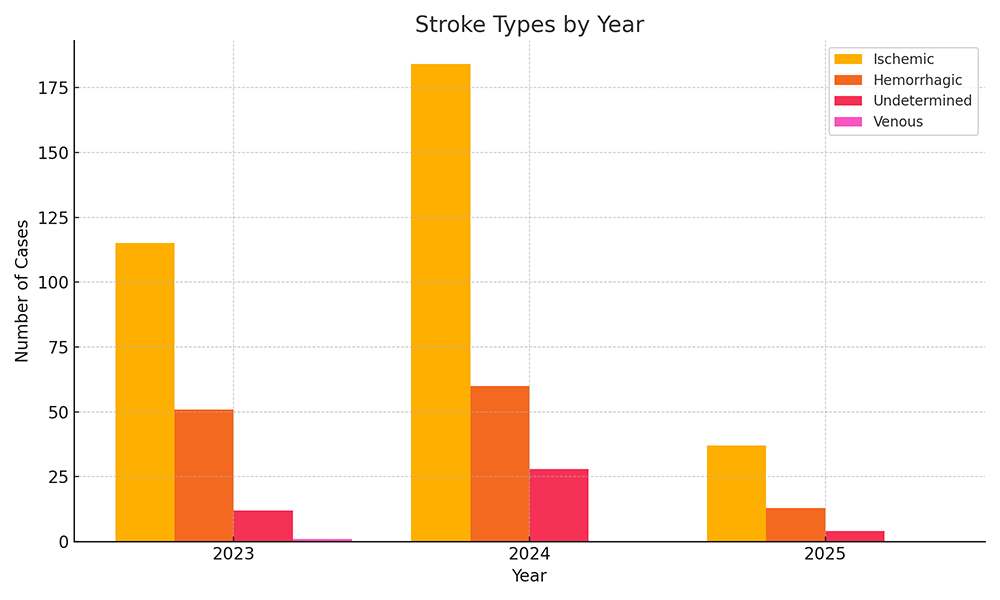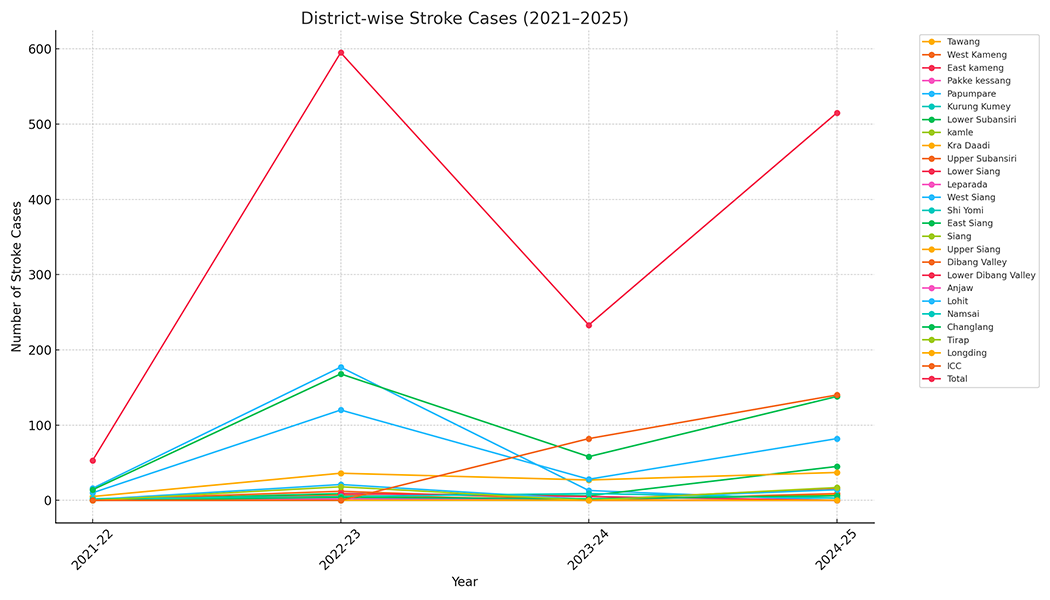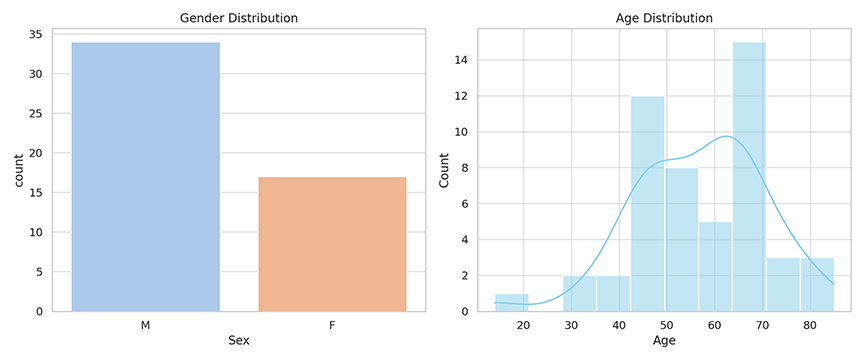[Dr Nareng Padun]
A stroke is a medical emergency that occurs when blood flow to the brain is disrupted, leading to brain cell damage or death. It can cause significant disability or even death if not treated promptly.
Understanding the causes, symptoms, and prevention strategies can help reduce the risk and improve outcomes.
Types of strokes
Strokes are categorized into three main types:
- Ischemic stroke: The most common type, caused by a blockage in an artery supplying blood to the brain, often due to a blood clot or a buildup of fatty deposits (atherosclerosis).
- Haemorrhagic stroke: Occurs when a weakened blood vessel bursts, leading to bleeding in or around the brain. Causes include high blood pressure, aneurysms, or arteriovenous malformations (AVMs).
- Transient ischemic attack (TIA): Often called a mini-stroke, it involves a temporary blockage of blood flow to the brain, resolving within 24 hours. While not causing permanent damage, a TIA is a serious warning sign of a possible future stroke.
Causes and risk factors
Several factors can increase stroke risk, including:
- High blood pressure: The leading cause, as it weakens blood vessels over time.
- Heart disease: Conditions like atrial fibrillation can lead to clot formation.
- Diabetes: High blood sugar levels damage blood vessels.
- Smoking and alcohol consumption: Both contribute to high blood pressure and clot risks.
- Obesity and sedentary lifestyle: Poor diet and lack of physical activity are major contributors.
- Family history: Genetic predisposition can play a role.
- Age and gender: – Risk increases with age; men are generally at higher risk, though women can also be severely affected.
Burden of stroke
Global Impact: As published in September 2024 in Lancet, neurology stroke remains a leading cause of death and disability worldwide.
Globally, an estimated 15 million people suffer a stroke annually, with 5 million deaths and 5 million left permanently disabled.
According to the most recent Global Burden of Disease (GBD) estimates, there were around 12.2 million incidents of stroke, 143 million disability-adjusted life-years (DALYs) lost, and 6.6 million deaths globally in 2019, making stroke the second leading cause of death and third leading cause of disability worldwide. Over the past 30 years, there has been an increase in the absolute number of incident (70%) and prevalent (85%) strokes, as well as deaths (43%) from stroke.
In India, as per the 2021 published data, the burden of stroke in India is increasing and stroke is the fourth leading cause of death and the fifth leading cause of disability.
Our state Arunachal Pradesh
In our state also number of cases is increasing as given in figures 1, 2 and 3.
Figure 1: TRIHMS stroke cases analysis (2023-February 2025).
In figure 1, you can see clearly that ischemic stroke is the most common each year and increase from 2023 to 2024. The abovementioned data is only from the TRIHMS. There are many hospitals in the capital region (Heema, RKMH, Hormin, etc) where some stroke cases get treated.
Figure 2: District-wise stroke report (2021-2025). The chart visualizes the stroke case trends across different districts from 2021 to 2025 as reported under the NP-NCD programme.
In figure 2 we see that-
- General trends:
– Overall increase: There’s a noticeable increase in stroke cases in many districts between 2021-22 and 2022-23, followed by some fluctuation in later years.
– Spike in 2022-23: Several districts saw a peak in stroke cases during this year, especially Papum Pare and Kra Daadi.
- High-burden districts:
– Papum Pare stands out with a major spike in 2022-23, reporting 177 cases, the highest across all years and districts.
– Kra Daadi and ICR (Itanagar Capital Region) also show consistent or sudden increases, indicating possible emerging hotspots.
- Low/stable districts:
Districts like Kurung Kumey, Longding, and East Kameng report consistently low or zero cases, which could reflect either better health or underreporting.
- Year-on-year comparison:
– 2021-22: Lowest number of cases across the board – possibly due to under-diagnosis or early stage of programme rollout.
– 2022-23: The year with the most significant increase in many districts.
– 2023-24 and 2024-25: Mixed trends – some districts saw decreases; others saw new spikes.
Figure 3: Graphical analysis of patients on rehabilitation (March 2025)
In figure 3, the gender distribution shows a higher number of male patients compared to female patients.
The age distribution indicates that most patients are between 40 and 70 years old, with a peak around the 60-70 age range.
So, from the above three data we can see that stroke data in our state are just an iceberg phenomenon, as large numbers of cases are not reported and numbers of cases not seeking medical treatment.
On March 2025, 94 CVA patients were undergoing physiotherapy in seven physiotherapy centres (not all collected), even after the CVA patients and the patients’ attendant had to go through many problems, weighted down by distress and financial burden for the family and state indirectly and directly. So, getting right treatment in right time can prevent it, ie,reaching in the window period to the hospital and preventing disability.
Symptoms of stroke
Recognizing symptoms early can save lives. Use the FAST acronym:
– F (Face) – Drooping or numbness on one side of the face.
– A (Arms) – Weakness or numbness in one arm; difficulty raising both arms evenly.
– S (Speech) – Slurred or garbled speech; difficulty understanding.
– T (Time) – Call emergency services immediately -time is critical.
Other signs may include:
– Sudden severe headache
– Dizziness or loss of balance
– Blurred or double vision
– Confusion or trouble understanding speech
Diagnosis and treatment
Strokes are diagnosed through proper history and examination, along with:
– Imaging tests: CT scans, MRIs, or cerebral angiography to identify underlying conditions and stroke type.
Treatment depends on stroke type:
– Ischemic stroke: May involve clot-busting medications like tPA, if reached hospital in right time (window periods ie, four -and-half hours), which will prevent disability, which is available at TRIHMS Naharlagun.
– Haemorrhagic stroke: Focuses on stopping the bleeding, reducing pressure in the brain, and possibly surgical intervention.
– Rehabilitation: Physical, occupational, and speech therapy help restore function and quality of life.
Prevention strategies
Lower your risk with these key measures:
– Control blood pressure and diabetes: Monitor regularly and take medications as prescribed.
– Eat a healthy diet: Emphasize fruits, vegetables, whole grains, and lean proteins; reduce salt and trans fats.
– Exercise regularly: Aim for at least 30 to 45 minutes of moderate activity most days.
– Avoid smoking and excessive alcohol: Quit smoking and keep alcohol intake in check.
– Manage stress: Use techniques like mindfulness, meditation, or yoga.
Conclusion
Stroke is a potentially life-threatening condition, distressing, and financially draining, but it’s also largely preventable. By understanding its causes, recognizing the symptoms early, and adopting healthier lifestyle habits, you can significantly reduce your risk. Prompt medical attention and early intervention can make all the difference in recovery and long-term outcomes. (Dr Nareng Padun is a consultant neurologist)





